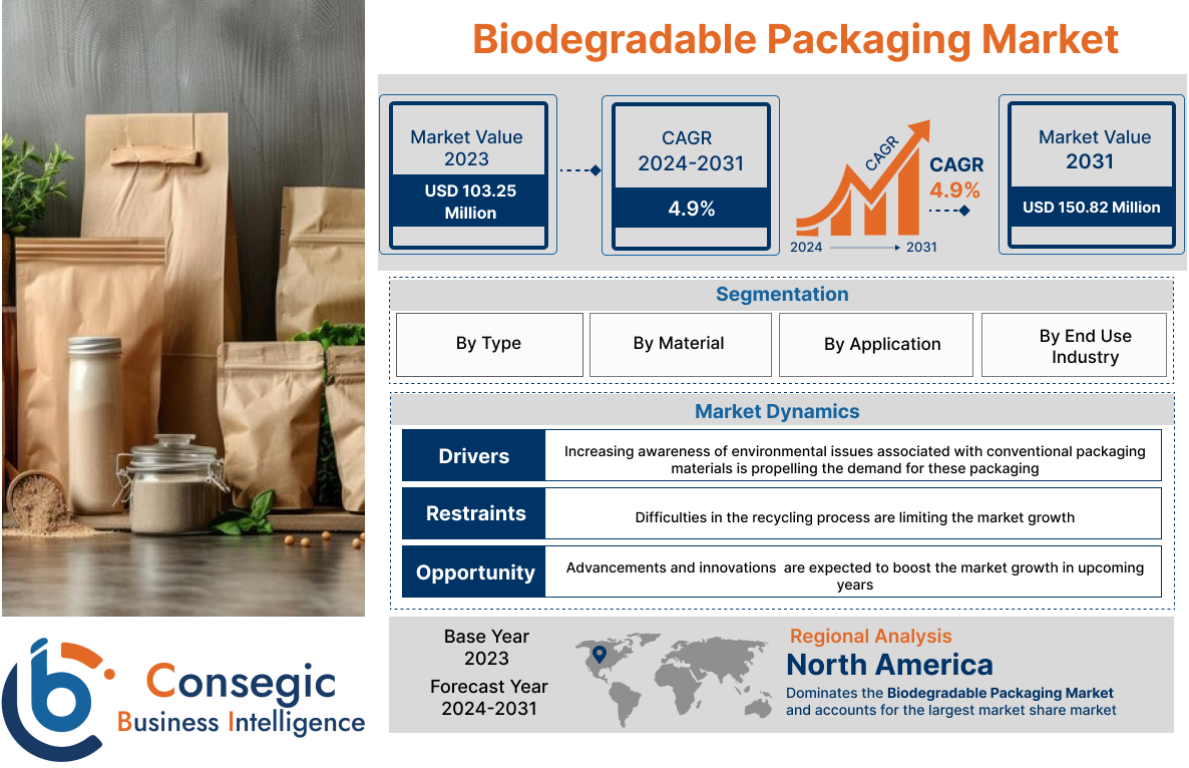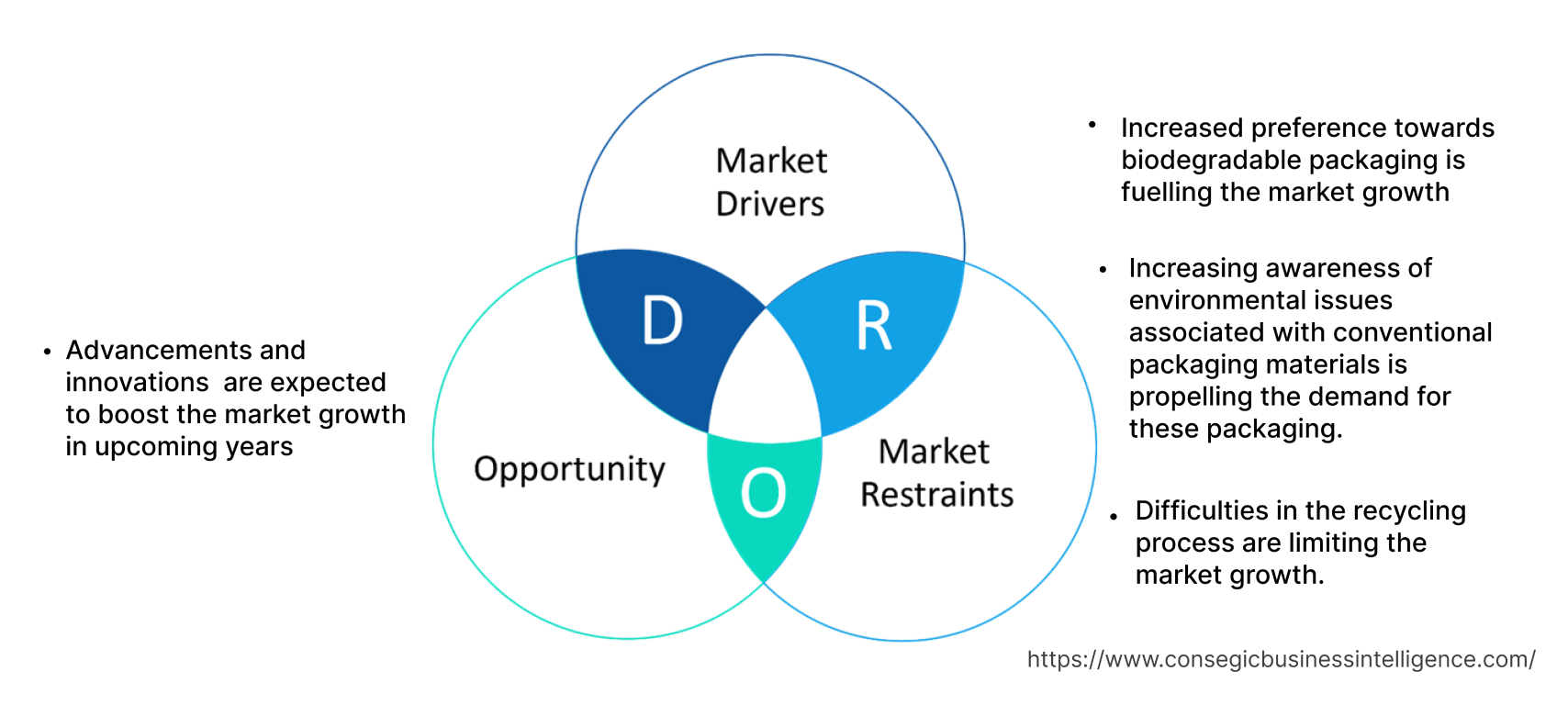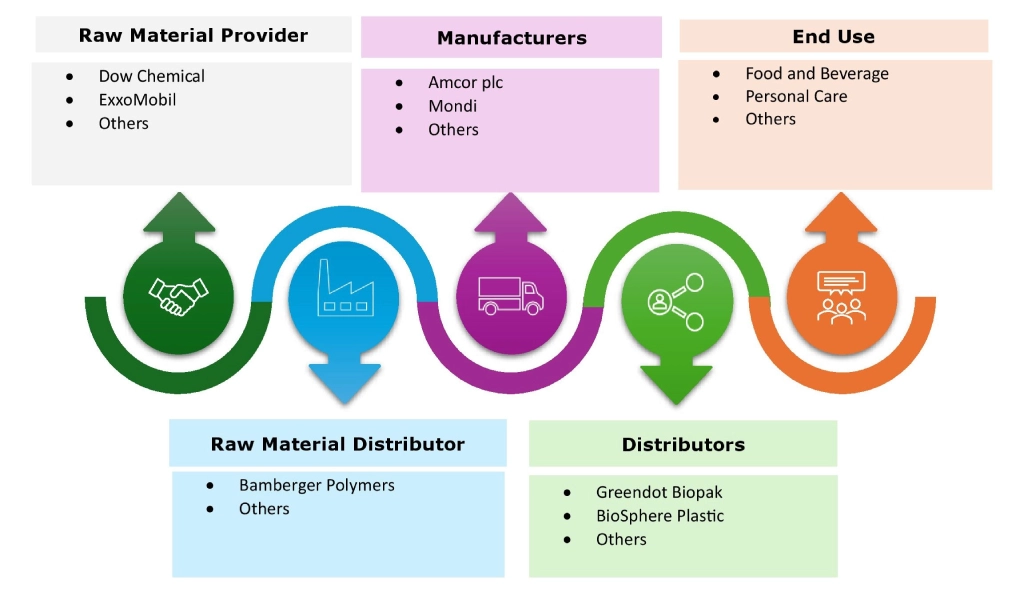Biodegradable Packaging Market Size :
Biodegradable Packaging Market Size is estimated to reach over USD 167.19 Billion by 2032 from a value of USD 107.18 Billion in 2024 and is projected to grow by USD 111.90 Billion in 2025, growing at a CAGR of 5.1% from 2025 to 2032.
Biodegradable Packaging Market Scope & Overview :
Biodegradable packaging is designed to naturally and safely decompose in the environment. Unlike conventional packaging that can persist for a prolonged period, these materials are broken down by microorganisms in soil or water. The motive of this type of packaging is to minimize the environmental footprint of products by ensuring their rapid and natural degradation upon disposal, without negatively impacting the climate, oceans, or overall environment.
How is AI Impacting the Biodegradable Packaging Market?
AI is revolutionizing the biodegradable packaging market by optimizing every stage of the product lifecycle. Using machine learning, companies can analyze vast material data to design packaging that is both functional and minimizes material use, accelerating the development of new, high-performance biodegradable films and composites. AI-powered vision systems in production lines ensure quality control by detecting subtle defects, reducing waste and improving consistency. Furthermore, AI helps optimize logistics by designing right-sized packaging, which lowers transportation costs and carbon emissions. Technology also aids in consumer engagement by providing information on a product's biodegradability and proper disposal, fostering a more sustainable circular economy.
Biodegradable Packaging Market Insights :
Biodegradable Packaging Market Dynamics - (DRO) :
Key Drivers :
Growing innovation and technological advancements in biodegradable materials are driving the biodegradable packaging market expansion
The rising innovations and technological advancements in biodegradable materials play a crucial role in market development. Researchers and companies are investing significantly in developing new biopolymers that can degrade more efficiently and possess enhanced properties suitable for various applications. For instance, advancements in polylactic acid (PLA) and polyhydroxyalkanoates (PHA) have led to sustainable packaging solutions that offer comparable performance to traditional plastics. These innovations are making sustainable packaging more appealing to mainstream manufacturers, thereby expanding their market share.
- For instance, in January 2024, Sealed Air unveiled a new sustainable option for protein packaging, the CRYOVAC brand compostable overwrap tray. This innovative tray is made from a bio-based, food-contact grade resin and is certified for industrial composting, as well as soil and marine biodegradability. It serves as an eco-friendly alternative to conventional EPS foam trays. This launch aligns with Sealed Air's broader commitment to sustainability, which includes developing recyclable or reusable packaging and incorporating recycled or renewable materials. A key feature of this tray is its robust performance, maintaining integrity even in extreme temperatures and during shipping, marking a notable advancement in sustainable packaging solutions.
Thus, according to the biodegradable packaging market analysis, growing innovation and technological advancements in biodegradable materials are driving the biodegradable packaging market size and trends.
Key Restraints :
Difficulties in the recycling process are limiting the market gHigher costs of biodegradable materials are affecting the biodegradable packaging market demand rowth
The production of biodegradable materials involves complex processes and higher raw material costs, making them more expensive. This cost factor can limit the adoption of sustainable packaging, especially among small and medium-sized enterprises. Additionally, the performance and durability of some biodegradable materials may not yet match those of conventional plastics, which can limit their adoption in certain applications. Thus, the aforementioned factors would further impact the biodegradable packaging market size.
Future Opportunities :
Increasing consumer demand for sustainable and eco-friendly products is expected to drive the biodegradable packaging market opportunities
As environmental awareness continues to rise, consumers are actively seeking packaging solutions that minimize their impact on the planet. This growing demand for sustainable packaging presents a significant opportunity for manufacturers to develop and offer innovative eco-friendly packaging solutions that cater to various industries and applications. Companies that can effectively address consumer preferences for sustainability are likely to gain a competitive edge in the market.
- For instance, Peel-On, a U.S.-based company, has developed Peel ON-Fresh, an innovative plant-based and fully biodegradable packaging material. This solution is designed to significantly extend the shelf life of most fruits and vegetables, reportedly by up to 100%.
Thus, based on the above biodegradable packaging market analysis, the above factors are expected to drive the biodegradable packaging market opportunities.
Biodegradable Packaging Market Segmental Analysis :
By Type :
Based on type, the market is segmented into paper and plastic.
Trends in the type:
- Rising adoption of paper packaging due to its lower environmental impact is driving the market.
- The continuous development of new biodegradable materials and their incorporation into packaging applications are expected to drive the segment development.
- Thus, based on the above analysis, these factors are driving the biodegradable packaging market demand.
The paper segment accounted for the largest revenue share in the year 2024.
- Consumers are increasingly opting for products with eco-friendly packaging, compelling manufacturers to innovate and adopt biodegradable materials. This shift in consumer behaviour is further amplified by social media campaigns and educational programs highlighting the benefits of biodegradable and sustainable packaging.
- Government regulations and policies are another significant driver for the market. Various countries have implemented stringent laws and guidelines to control plastic pollution.
- For instance, the European Union's Single-Use Plastics Directive aims to reduce the impact of certain plastic products on the environment by promoting the use of biodegradable alternatives.
- Thus, based on the above analysis, these factors are further driving the biodegradable packaging market growth.
The plastic segment is anticipated to register the fastest CAGR during the forecast period.
- Starch-based plastics are widely used due to their abundance and cost-effectiveness. These materials are easily biodegradable and are employed in various packaging applications, particularly in the food and beverage sector.
- The increasing demand for sustainable packaging solutions in the personal care and pharmaceutical sectors is driving the development of cellulose-based plastics. Their ability to provide a barrier against moisture and oxygen further enhances their appeal in these industries.
- Polylactic acid (PLA) packaging offers excellent transparency and printability, making it ideal for food packaging applications. The growing consumer preference for eco-friendly packaging and advancements in PLA technology are driving its adoption across various industries.
- Thus, based on the above analysis, these factors are expected to drive the biodegradable packaging market share during the forecast period.
By Material :
Based on the material, the biodegradable packaging market is segmented into bioplastic, cornstarch, seaweeds, mushroom, and others.
Trends in the material:
- The use of biodegradable materials in food packaging is gaining traction due to their ability to maintain product integrity while being environmentally friendly.
- Biodegradable plastic packaging is more suitable for products that require moisture resistance, such as fresh produce and frozen foods. Both materials have their unique advantages and are expected to grow simultaneously, driven by the increasing demand for sustainable packaging solutions.
The bioplastic segment accounted for the largest revenue share in the year 2024.
- Bioplastic packaging offers a sustainable alternative to conventional plastics, as it is made from renewable resources like plants, starches, or agricultural by-products. Bioplastics can naturally degrade, lessening the environmental impact of plastic waste.
- They are specifically designed to be compostable or biodegradable, presenting a more environmentally conscious choice.
- For instance, in May 2021, TerraVerdae introduced a new range of PHA-based bioplastic resins. These resins are both biodegradable and sustainable, offering a viable and eco-friendly alternative to traditional plastics. This development is further contributing to the growth of the bioplastics market.
- Thus, based on the above analysis, these factors would further supplement the biodegradable packaging market
The mushroom segment is anticipated to register the fastest CAGR during the forecast period.
- Mushroom mycelium packaging utilizes the root-like fungal threads, called mycelium, to produce sustainable packaging.
- Mycelium readily grows on agricultural waste, forming a robust and adaptable material that can be molded into various forms, serving as a replacement for conventional foam or plastic packaging.
- This environmentally friendly option is gaining traction due to its low environmental impact. Mycelium packaging is compostable and can even enrich soil as fertilizer.
- These factors are anticipated to further drive the biodegradable packaging market trends during the forecast period.
By Application :
Based on application, the market is segmented into bottles, cups, boxes and cartons, bags, wraps, and others.
Trends in the application:
- Biodegradable trays are made from materials such as molded pulp and bio-based plastics, providing a sustainable alternative to traditional plastic trays. The increasing demand for sustainable packaging solutions in various industries is driving the growth of the segment.
- The development of biodegradable bottles with improved properties, such as transparency and shelf-life, is further boosting their adoption.
The boxes and cartons segment accounted for the largest revenue in the year 2024.
- Boxes are an essential packaging type in the biodegradable packaging market. They are used to package a wide range of products, including food and beverages, personal care items, and industrial products.
- Biodegradable boxes are made from materials such as corrugated paper, recycled paper, and biodegradable plastics.
- These boxes offer excellent strength and durability, ensuring the safe transportation and storage of products.
- The increasing need for sustainable packaging solutions in e-commerce and retail is driving the growth of the biodegradable boxes segment.
- Thus, based on the above analysis, these factors are driving the biodegradable packaging market growth and trends.
The bottles segment is anticipated to register the fastest CAGR during the forecast period.
- Bottles are widely used in the packaging of beverages, personal care items, and household products.
- Moreover, biodegradable bottles are made from materials such as PLA, PHA, and other bio-based plastics.
- These bottles decompose naturally, reducing environmental impact. The need for biodegradable bottles is driven by the increasing awareness about plastic pollution and the growing preference for eco-friendly packaging solutions.
- These factors are anticipated to further drive the biodegradable packaging market trends during the forecast period.
By End-Use Industry :
Based on end use, the market is segmented into food and beverages, pharmaceuticals, personal care, and others.
Trends in the end use:
- The hospitality industry is increasingly adopting sustainable packaging for food and beverage services to meet customer preferences and reduce their environmental footprint.
- The healthcare sector is increasingly using eco-friendly packaging for medical devices and pharmaceutical products. The need for safe, sterile, and environmentally friendly packaging in the healthcare sector is driving the need for biodegradable materials.
The food and beverages companies segment accounted for the largest revenue share of 48.79% in the year 2024 and it is expected to register the highest CAGR during the forecast period.
- The food & beverage sector is the largest application segment, driven by the increasing need for sustainable and eco-friendly packaging options.
- Consumers are becoming more conscious of the environmental impact of their choices, leading to a surge in the rising need for biodegradable packaging in this sector.
- Additionally, stringent regulations regarding food safety and packaging materials are further boosting the adoption of eco-friendly packaging solutions.
- For instance, in May 2023, BASF introduced Ecovio, a biopolymer line specifically designed for paper-based packaging of various food items. This includes containers for hot and cold beverages, snacks, and food wrapping paper.
- Thus, the above developments are driving the global market trends.

By Region :
The global market has been classified by region into North America, Europe, Asia-Pacific, Middle East & Africa, and Latin America.
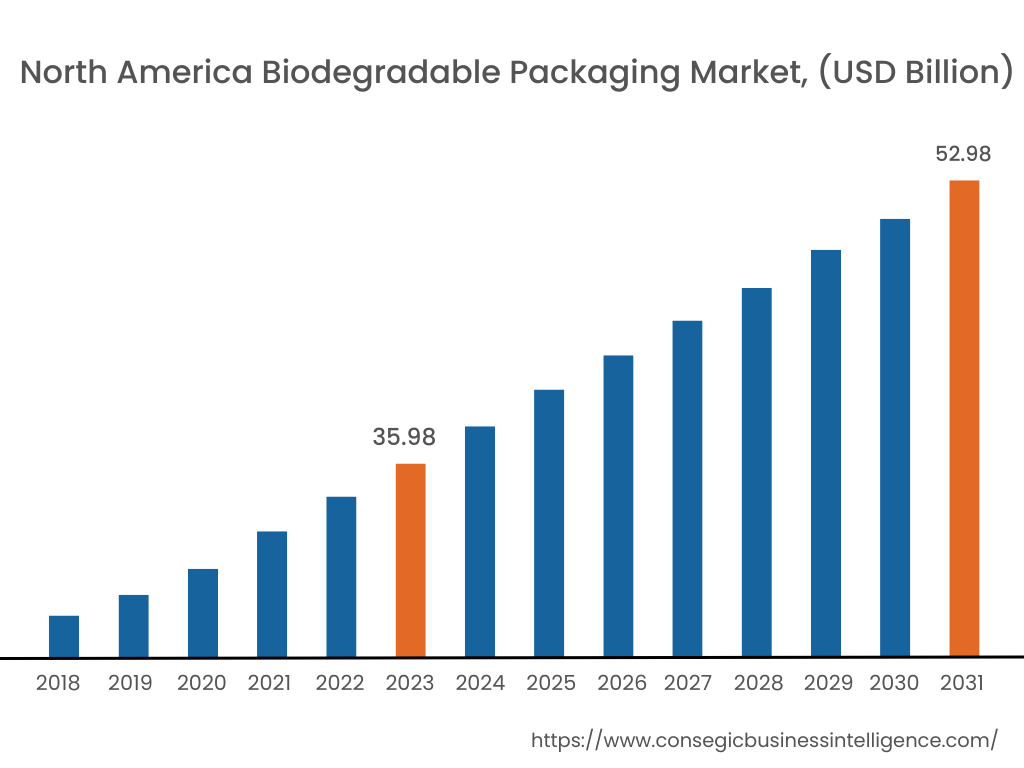
Asia Pacific biodegradable packaging market expansion is estimated to reach over USD 45.88 billion by 2032 from a value of USD 27.72 billion in 2024 and is projected to grow by USD 29.08 billion in 2025. Out of this, the China market accounted for the maximum revenue split of 35.74%. Rapid industrialization, urbanization, and increasing environmental regulations are driving the need for sustainable packaging solutions in the region. Further, the growing awareness of plastic pollution and government initiatives to reduce plastic waste are major factors contributing to market growth in the Asia Pacific region. Additionally, the expanding middle-class population and changing consumer preferences towards eco-friendly products are further propelling the adoption of biodegradable and sustainable packaging in the region. These factors would further drive the regional biodegradable packaging market during the forecast period.
- For instance, in December 2023, SABIC and CJ CheilJedang partnered to produce Hetbahn instant rice packaging bowls using renewable polypropylene (PP) resins. This collaboration is part of their sustainable packaging efforts in the Asia Pacific region and introduced ISCC PLUS certified food packaging, highlighting their dedication to environmentally responsible practices.
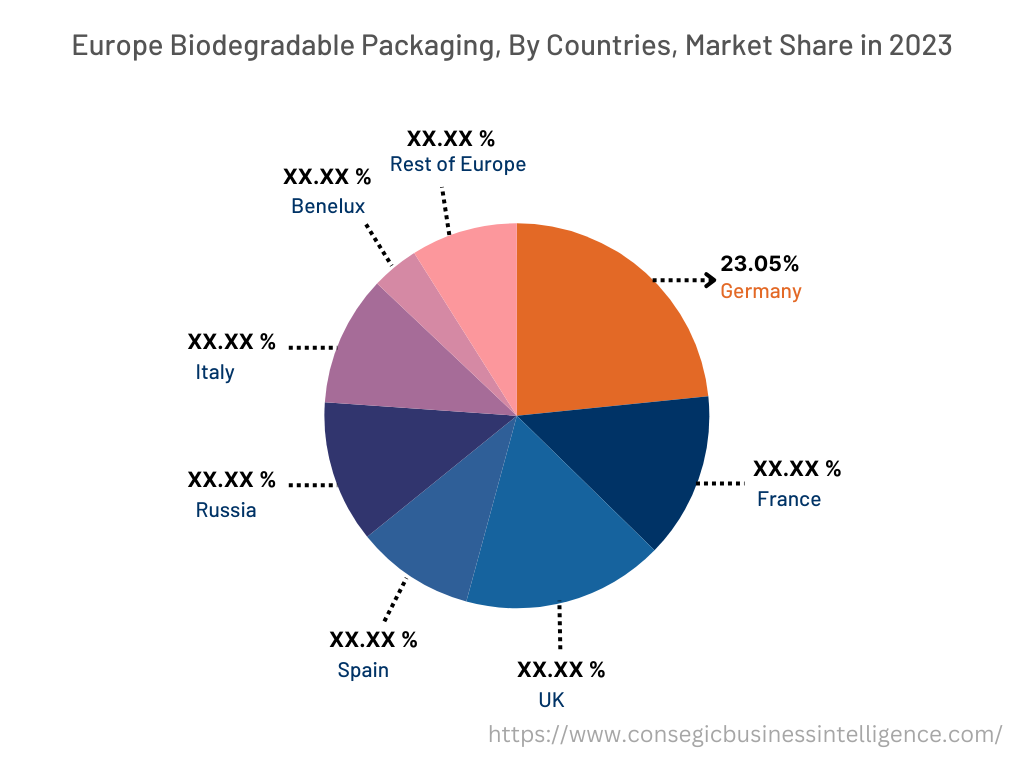
North America market is estimated to reach over USD 57.21 billion by 2032 from a value of USD 36.99 billion in 2024 and is projected to grow by USD 38.59 billion in 2025. The United States and Canada have witnessed a growing trend of sustainable packaging in response to rising environmental concerns. The food and beverage industry is a significant contributor to the need for biodegradable packaging in North America. Additionally, the presence of major biodegradable packaging manufacturers and ongoing research and development activities in the region further support the market growth. Hence, the aforementioned factors would further drive the market in North America.
According to the analysis, the biodegradable packaging industry in Europe is expected to witness significant development during the forecast period. The European Union has implemented various directives and regulations to reduce plastic waste and promote sustainable packaging solutions. As a result, many European countries have adopted biodegradable packaging across various industries, including food and beverage, pharmaceuticals, and personal care. Additionally, the Latin America region's commitment to reducing plastic waste and promoting circular economy principles is expected to drive market development. Further, government policies in the Middle East & Africa region aimed at reducing plastic pollution and promoting sustainable practices are creating a favorable environment for the adoption of biodegradable packaging.
Top Key Players & Market Share Insights :
The global biodegradable packaging market is highly competitive with major players providing solutions to the national and international markets. Key players are adopting several strategies in research and development (R&D), product innovation, and end-user launches to hold a strong position in the market. Key players in the biodegradable packaging industry include-
The key players in the market include-
- Amcor plc (Switzerland)
- Mondi (U.K.)
- Tetrapak (Switzerland)
- Pactiveevergreen (U.S.)
- Evergreen packaging (U.S.)
- WestRock (U.S.)
- Kruger Inc. (Canada)
- Green Pack (India)
- Smurfit Kappa Group (Ireland)
- Ranpak (U.S.)
Recent Industry Developments :
Partnership:
- In February 2025, Avantium N.V. announced the partnership with Amcor plc, to discover using Avantium's plant-based polymer, PEF (polyethylene furanoate), in rigid containers. This collaboration aims to develop sustainable packaging solutions for a wide range of products, including food, beverages, pharmaceuticals, medical supplies, and home and personal care items.
Biodegradable Packaging Market Report Insights :
| Report Attributes | Report Details |
| Study Timeline | 2039-2032 |
| Market Size in 2032 | USD 167.19 Billion |
| CAGR (2025-2032) | 5.1% |
| By Type |
|
| By Material |
|
| By Application |
|
| By End-use Industry |
|
| By Region | North America, Europe, Asia Pacific, Latin America, and Middle East & Africa |
| Key Players |
|
| Geographies Covered | |
| North America | U.S. Canada Mexico |
| Europe | U.K. Germany France Spain Italy Russia Benelux Rest of Europe |
| APAC | China South Korea Japan India Australia ASEAN Rest of Asia-Pacific |
| Middle East and Africa | GCC Turkey South Africa Rest of MEA |
| LATAM | Brazil Argentina Chile Rest of LATAM |
| Report Coverage | Revenue Forecast, Competitive Landscape, Growth Factors, Restraint or Challenges, Opportunities, Environment & Regulatory Landscape, PESTLE Analysis, PORTER Analysis, Key Technology Landscape, Value Chain Analysis, Cost Analysis, and Regional Trends & Forecast |
Key Questions Answered in the Report
How big is the Biodegradable Packaging Market? +
Biodegradable Packaging market size is estimated to reach over USD 167.19 Billion by 2032 from a value of USD 107.18 Billion in 2024 and is projected to grow by USD 111.90 Billion in 2025, growing at a CAGR of 5.1% from 2025 to 2032.
Which is the fastest-growing region in the Biodegradable Packaging Market? +
Asia-Pacific region is experiencing the most rapid growth in the market.
What specific segmentation details are covered in the Biodegradable Packaging report? +
The biodegradable packaging report includes specific segmentation details for type, material, application, end use, and region.
Who are the major players in the Biodegradable Packaging Market? +
The key participants in the market are Amcor plc (Switzerland), Mondi (U.K.), WestRock (U.S.), Kruger Inc. (Canada), Green Pack (India), Smurfit Kappa Group (Ireland), Ranpak (U.S.), Tetrapak (Switzerland), Pactiveevergreen (U.S.), Evergreen packaging (U.S.), and others.
Based on current market trends and future predictions, which geographical region is the dominant Biodegradable packaging region in the Biodegradable packaging Market? +
Europe accounted for the highest market share in the overall market.
